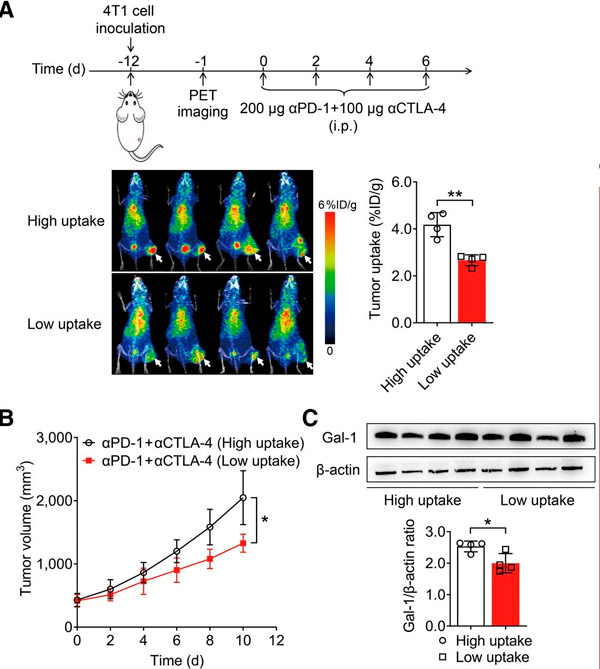Nye publikasjoner
Ny biomarkør gjør det mulig for leger å forutsi tumorrespons før behandlingen starter
Sist anmeldt: 02.07.2025

Alt iLive-innhold blir gjennomgått med medisin eller faktisk kontrollert for å sikre så mye faktuell nøyaktighet som mulig.
Vi har strenge retningslinjer for innkjøp og kun kobling til anerkjente medieområder, akademiske forskningsinstitusjoner og, når det er mulig, medisinsk peer-evaluerte studier. Merk at tallene i parenteser ([1], [2], etc.) er klikkbare koblinger til disse studiene.
Hvis du føler at noe av innholdet vårt er unøyaktig, utdatert eller ellers tvilsomt, velg det og trykk Ctrl + Enter.

Proteinet galectin-1 (Gal-1) er identifisert som en ny biomarkør for PET-avbildning brukt i immunterapi med checkpoint-blokade (ICB), slik at leger kan forutsi tumorrespons før behandling.
Informasjon innhentet fra Gal-1 PET-avbildning kan også brukes til å stratifisere pasienter og optimalisere immunterapi, noe som muliggjør målrettede intervensjoner og forbedrede pasientresultater. Studien ble publisert i maiutgaven av The Journal of Nuclear Medicine.
Immunterapier som ICB har vist oppmuntrende kliniske resultater ved melanom, ikke-småcellet lungekreft og flere andre svulsttyper. Imidlertid opplever bare en undergruppe av pasientene positive resultater, med objektive responsrater fra 5 % til 60 %.
«Det er fortsatt utfordrende å utvikle pålitelige tilnærminger for å vurdere responser og velge passende pasienter for immunterapi», sa Zhaofei Liu, PhD, en fremtredende professor ved Peking University i Kina.
«Nåværende kliniske kriterier for overvåking av responser på immunterapi i solide svulster er basert på CT og MR, men disse metodene resulterer i en betydelig forsinkelse mellom behandlingsstart og vurdering av respons. Molekylære avbildningsteknikker, spesielt PET, har dukket opp som pålitelige verktøy for å forutsi effekten av immunterapi gjennom kvantitativ og ikke-invasiv vurdering av biomarkører i sanntid.»

124I-αGal-1 PET-skanning forutsier effekten av behandling med immunkontrollpunkthemmere (ICB). Kilde: N Liu og X Yang et al., Peking University, Beijing, Kina.
Studien brukte en musemodell for å identifisere nye avbildningsbiomarkører for tumorresponser på ICB-behandling. Ved hjelp av proteomisk analyse (separering, identifisering og kvantifisering av proteiner i tumoren) fant forskerne at tumorer med lav Gal-1-ekspresjon responderte positivt på ICB-behandling.
Gal-1 ble deretter merket med 124I, og radiotraceren (124I-α-Gal-1) ble brukt i PET-avbildning og distribusjonsstudier av små dyr for å evaluere spesifisiteten til radiotraceren. PET-avbildning med 124I-αGal-1 avslørte den immunsuppressive statusen til tumormikromiljøet, noe som tillot prediksjon av resistens mot ICB-behandling før behandling.
For svulster som ikke var forventet å respondere godt på ICB-behandling, utviklet forskerne en redningsstrategi ved bruk av en Gal-1-hemmer som forbedret sjansene for suksess betydelig.
«Gal-1 PET åpner muligheten for tidlig prediksjon av ICB-effekt før behandling og legger til rette for presis utforming av kombinasjonsregimer», bemerket Liu. «Denne sensitive tilnærmingen har potensial til å oppnå individualisert presisjonsbehandling for pasienter i fremtiden.»
